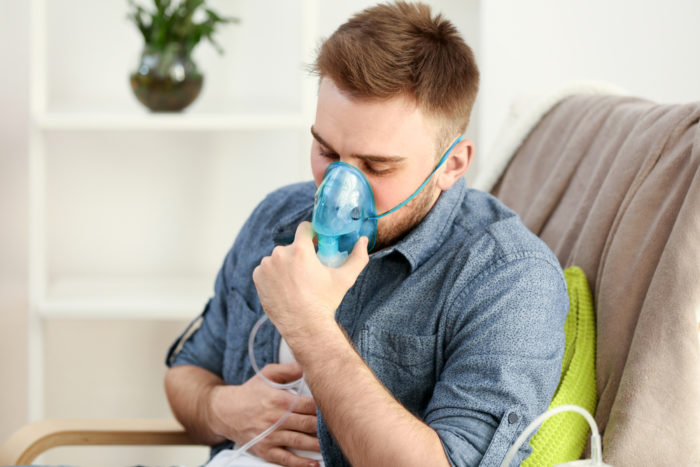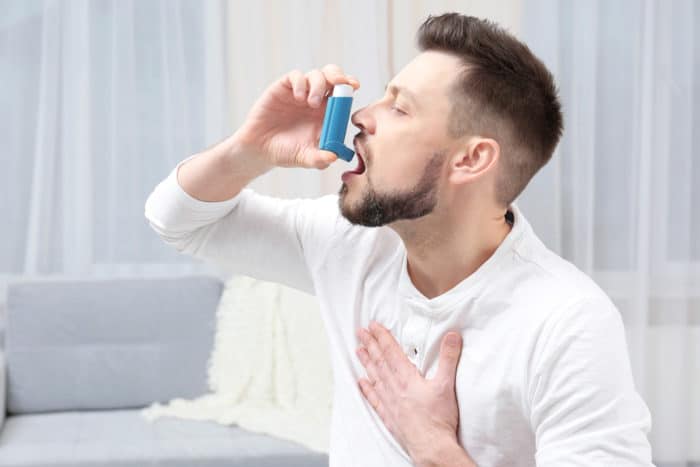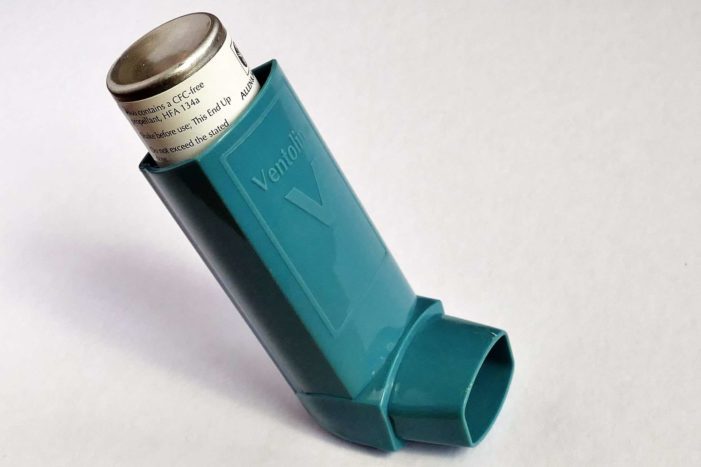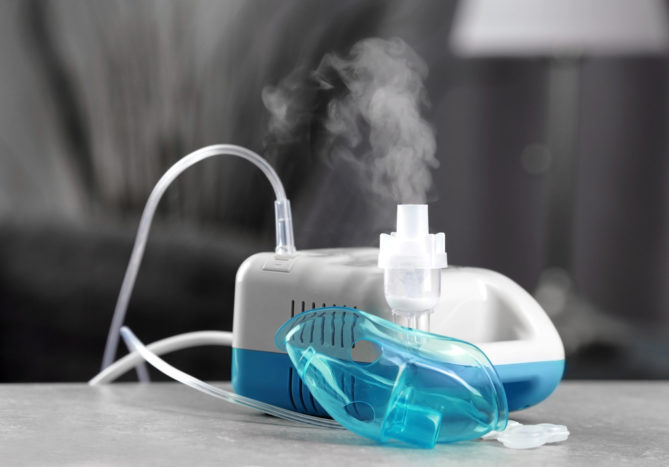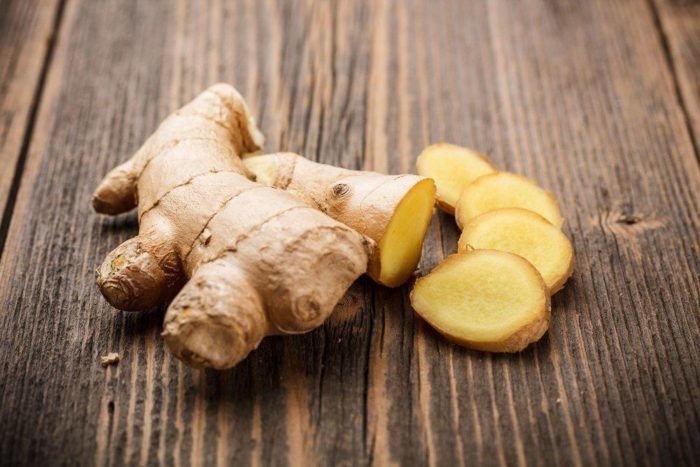Contents:
- Medical Video: How to Naturally Treat Asthma
- First know how severe your asthma symptoms are
- 1. Intermittent asthma
- 2. Mild persistent asthma
- 3. Moderate persistent asthma
- 4. Severe persistent asthma
- Choice of asthma treatment from a doctor
- 1. Long-term asthma treatment
- 2. Short-term asthma treatment
- Respiratory aids are useful for controlling asthma
- 1. Inhaler
- 2. Nebulizer
- Asthma treatment with natural ingredients in the kitchen
- 1. Ginger
- 2. Garlic
- 3. Caffeine
- 4. Honey
- The natural way to control asthma symptoms without drugs
- 1. Avoid triggers of asthma and allergies
- 2. Using air filters
- 3. Immunotherapy
- 4. Using preventive treatment
- 5. Routinely check lung function
Medical Video: How to Naturally Treat Asthma
Asthma cannot be cured. Even so, there are many drugs that you can use to control the symptoms so that they don't easily recur. Starting from the medication prescribed by the doctor to using natural ingredients from the kitchen, the following recommendations for the best asthma treatment.
But before carelessly trying asthma drugs, it's important for you to understand first how severe the symptoms of asthma you experience.
First know how severe your asthma symptoms are
Asthma symptoms recur and can appear suddenly in unexpected times and places. Well, how often your asthma attacks relapse actually relates to the severity of the disease. So, you must first know how severe your asthma is. The goal is so that you can anticipate what you need to do and what medication is suitable for handling it when the next attack recurs.
To find out how severe your asthma is, try answering the following questions:
- How many days a week, you experience chest tightness, coughing, difficulty breathing, and shortness of breath?
- How often in one week, do you use an inhaler as a medicine to treat your asthma?
- Does your asthma cause your activity to be interrupted?
- Do you often wake up at night due to experiencing asthma symptoms? How often do you wake up in one week?
From these answers, you can knowhow severe your asthma is by looking at the following types of asthma severity.
1. Intermittent asthma
Has characteristics such as:
- Symptoms relapse 1-2 times a week.
- Waking up in the middle of the night 1-2 times in one month.
- Use an inhaler twice or less per week.
- Do not experience interference when on the move.
This type of asthma does not need specific treatment to control asthma, but you need to avoid various things that can trigger asthma.
2. Mild persistent asthma
Has characteristics such as:
- Symptoms appear more than 2 times a week.
- Wake up in the middle of the night to 3-4 times in one month.
- Use an inhaler more than 2 times per week.
- Activity is a little disturbed.
For this type of asthma, your doctor will only prescribe you anti-inflammatory drugs to treat the symptoms.
3. Moderate persistent asthma
Has characteristics such as:
- Symptoms appear almost every day.
- Waking up in the middle of the night more than twice a week.
- Use an inhaler almost every day
- Disturbed activity.
People who have moderate persistent asthma will be given drugs to control their asthma. In addition, people who have this type of asthma will be encouraged to take bronchodilator therapy.
4. Severe persistent asthma
Has characteristics such as:
- Symptoms appear every day, even almost all day.
- Every day you wake up in the middle of the night.
- Using the inhaler is necessary several times a day.
- Very disturbed activity.
Asthma control drugs that are given to severe persistent asthma are not just one type. the doctor will give several combinations of glucocorticosteroid inhalers in high doses.
Choice of asthma treatment from a doctor
Treatment of asthma in doctors is generally divided into two categories, namely long-term and short-term treatment.
1. Long-term asthma treatment
Most people with asthma are encouraged to take long-term therapy. Long-term asthma treatment aims to control the severity of asthma symptoms and prevent it from recurring continuously.
Some types of long-term asthma control drugs include:
- Corticosteroid Inhaler (inhaler)
Corticosteroid inhalers are used to control asthma symptoms by inhibiting or reducing inflammation in the respiratory tract. With an inhaler, the frequency of recurrence of asthma can be suppressed and you can breathe more easily everyday.
Steroid drugs commonly used in inhalers include fluticasone (Flonase, Flovent HFA), budesonide (Pulmicort Felxhaler, Rhinocort), flunisolide (Aerospan HFA), ciclesonide (Alvesco, Omnaris, Zetonna), beclomethasone (Qnasl, Qvar), mometasone ( Asmanex) and fluticasone furoate (Arnuity Ellipta).
Unlike oral corticosteroids (drinking drugs), corticosteroid drugs breathe less risk of side effects so they are generally safe for long-term use. But you may need to continue using these drugs for several days to several weeks to get optimal benefits.
- Leukotriene modifiers
Leukotriene modifiers are a type of oral asthma treatment that works against leukotrienes. Leukotrienes are substances released by white blood cells in the lungs that cause obstructed air flow.
This medication is intended for asthma conditions caused by side effects of certain drugs, severe physical activity, or severe persistent asthma.
Medicines belonging to the leukotriene modiefiers are montelukast (Singulair), zafirlukast (Accolate) and zileuton (Zyflo). All of these medications help relieve asthma symptoms for up to 24 hours.
Unfortunately in some cases, these types of drugs can risk the risk of psychological side effects such as hallucinations, depression, and excessive anxiety. Immediately consult a doctor if you feel an unusual reaction.
- Long-acting beta agonists
Asthma treatment which is included in the long-acting beta agonist category is bronchodilator. Bronchodilators are therapies that consist of various drugs to increase lung capacity to absorb oxygen so you can breathe more smoothly and reliably.
Drugs commonly used in bronchodilator therapy include salmeterol (Serevent) and formoterol (Foradil, Perforomist). This bronchodilator must be combined with inhaled corticosteroids, and only given if the symptoms do not improve after inhaling corticosteroids.
This type of asthma treatment is more commonly used to control asthma symptoms triggered by exercise or heavy physical activity.
- Theophylline
Theophylline helps relax inflamed muscles around the airways (bronchi) so you can breathe more easily.
For some people, this drug may cause side effects such as headaches, vomiting and vomiting, and stomach disorders. But these side effects can be prevented by adjusting the dose.
2. Short-term asthma treatment
In addition to long-term asthma therapy, people with asthma also need short-term therapy that aims to immediately relieve acute asthma symptoms once the relapse attacks. Short-term therapy is also useful to prevent an asthma attack before exercise, if the doctor allows it.
These types of short-term medicines include:
- Short-acting beta2-agonist inhalers
This inhaler drug is a type of fast-acting bronchodilator. As the name implies, this asthma medication works quickly to stop the symptoms of asthma when a relapse attacks.
Albuterol, pirbuterol, and levalbuterol or bitolterol are the first choices for the treatment of short-term asthma. Short-acting beta agonists can be used using a handheld (portable) or nebulizer inhaler.
- Ipratopium
Ipratropium is more widely used to treat emphysema and chronic bronchitis. However, this drug can be used as a fast-acting bronchodilator therapy to immediately relax the muscles of the airway that are tightened when the asthma attacks relapse.
You can use this medicine when new asthma symptoms begin to appear.
- Oral and intravenous corticosteroids
If your doctor evaluates that your asthma symptoms cannot be controlled with an inhaler, he may prescribe oral steroids (oral medications) such as prednisone and methylprednisolone.
Even so, it should be noted that oral medications should only be used in the short term and only to treat severe asthma attacks. Usually doctors will prescribe oral steroids for only 1-2 weeks.
This is because oral steroid drugs can cause serious side effects if used in the long term. The side effects of long-term use of oral asthma medications include weight gain, hypertension, weakened muscles, easy bruising, bone loss, and so on.
If you feel you need to take short-term medication more than 2 days a week, immediately talk to your doctor about other solutions to control asthma symptoms. You may need to discuss with your doctor to change your asthma action plan to suit your current condition.
Respiratory aids are useful for controlling asthma
Inhaled asthma medications need the help of a special tool to convert liquid medicine into steam so that it can enter the lungs. The use of inhaled medication is considered more effective because it can send drugs directly to your respiratory tract.
The most commonly used breathing apparatus for people with asthma are inhalers and nebulizers. Both inhalers and nebulizers act to control symptoms and relieve recurrent asthma attacks.
Following are the steps for using an asthma inhaler and nebulizer.
1. Inhaler
There are many types of asthma inhalers that have different dosage strengths and functions. But basically, how to use the inhaler correctly and more effectively is as follows:
- Sit or stand upright when using an inhaler.
- Beat the inhaler well before inhaling it.
- Take a quick breath as soon as you press the inhaler.
- Hold your breath for at least 10 seconds after inhaling it.
- If you need to use more than one sniff per dose, wait a few minutes between each suction. If you use bronchodilator medicine work fast, give a 3-5 minute pause. For other types, give a 1 minute pause.
- Pull and exhale slowly between each suction.
Mouthpiece the inhaler (mouthpiece where you place your mouth) needs to be cleaned every time you use it. Dry it naturally. Do not use a cloth to wipe it dry.
As long as you use this tool as instructed by the doctor, the inhaler is very effective for controlling asthma and minimal side effects.
2. Nebulizer
If the inhaler is a small spray-shaped breathing apparatus, a machine-shaped nebulizer is turned on with battery or electric power. The inhaler has a small funnel for you to put your mouth in and breathe medicine, while the nebulizer is usually equipped with a hose that has a mask on the end for you to use when breathing medicine.
Nebulizer is more commonly used as a therapy for the treatment of chronic asthma or serious asthma cases, both in children and elderly parents. This is because compared to the inhaler, the steam produced by the nebulizer is so small that the drug can absorb more quickly into the targeted part of the lung.
There are many types of nebulizers, but generally the way to use nebulizer is as follows:
- Wash hands with soap under running water to prevent germs from entering the lungs through the hands that touch the nebulizer.
- Prepare the medicine to be used. If the medicine has been mixed, pour it directly into the nebulizer medicine container. If not, enter one by one using a pipette or syringe.
- Add saline fluid if needed and prescribe the doctor.
- Connect the medicine container to the machine and also the mask to the top of the container.
- Attach the mask to the face to cover the nose and mouth. Make sure the edges of the mask are well sealed with the face, so that no medicinal vapors escape from the sides of the mask.
- Turn on the engine then inhale with your nose and slowly remove it through your mouth.
- You can end it when there is no more steam coming out. This is a sign that the drug is up.
How to use a nebulizer generally takes approximately 15-20 minutes.
Asthma treatment with natural ingredients in the kitchen
In addition to asthma treatment from doctors mentioned above, a number of herbal ingredients can also be natural remedies to relieve asthma symptoms. Here are home asthma treatment options that might be useful for you:
1. Ginger
Recent research has found that ginger can help relieve inflammation and relax the muscles of the respiratory tract which are a result. Another study reports that the muscle relaxation effect of ginger is almost as effective as some types of asthma medications from doctors.
Ginger can be used to relieve asthma in various ways, such as:
- Blend the ginger until it becomes juice. Mix the same amount of ginger juice, pomegranate juice and honey. Drink 1 tablespoon of this mixture for 2 to 3 times a day.
- Mix 1 teaspoon of ginger juice with one half cup of water. Drink 1 tablespoon of this mixture every night.
- Cut small 3 cm ginger and simmer 5 minutes in a pot of boiling water. Wait until it's cold and drink.
- Chew the pieces of raw ginger with salt.
2. Garlic
Garlic has anti-inflammatory properties which are believed to be useful to reduce inflammation in the airways due to asthma. However, the use of garlic as an alternative medicine for asthma is still being studied further. So far there have been no studies that can prove that garlic is effective for the treatment of long-term asthma.
If you want to try it, it doesn't matter. Simmer 2-3 garlic cloves with 1½ cups of milk. Let it cool, then drink.
3. Caffeine
In one study it was said that caffeine can help control an asthma attack because it can act as a bronchodilator. Caffeine can be found in coffee, tea or chocolate. It is important to note that do not use caffeine as a routine asthma treatment.
4. Honey
A study published in the Canadian journal Family Physician reports drinking 2 teaspoons of honey before going to bed can help relieve coughing at night in children with asthma.
The sweetness of honey triggers the salivary glands to produce more saliva, so it can lubricate dry airways while diluting lung mucus causing shortness of breath. Honey can also reduce inflammation in the bronchial airways that trigger asthma.
To treat asthma, you can use honey in the following ways:
- Dilute 1 teaspoon of honey into a glass of lukewarm water. Drink about 3 times a day.
- Before going to bed, drink a mixture of 1 teaspoon of honey and 1 teaspoon of cinnamon powder. This herb can help you thin the phlegm in your throat and make you sleep better.
- Mix lemon juice into a glass of warm water and add 1 teaspoon of honey. Lemon has antioxidants that can strengthen the immune system and help thin mucus.
Remember! We recommend that you first consult a doctor before you decide to try any natural ingredients as an alternative treatment for asthma.
It is important to remember that "natural" does not always mean safer. There is not enough scientific data that can prove that herbal ingredients are truly effective in treating asthma symptoms. There may be a risk of long-term side effects that are not yet fully known. So, it is still wise to consider the asthma treatment you will choose.
The natural way to control asthma symptoms without drugs
In addition to using drugs, whether medical drugs or herbal medicines from natural ingredients, there are several lifestyle changes that you can do daily to control asthma symptoms. Among them:
1. Avoid triggers of asthma and allergies
There are many things that can trigger asthma. So it's important for you to know what specific things can trigger your asthma to recur in order to avoid it.
Various asthma triggers may include:
- Sportsor physical activity that is too heavy.
- Inhalant allergens, such as dust mites; stinging perfumes and fragrances; air pollution from vehicle exhaust fumes / factory waste chemical fumes / cigarette smoke; animal fur; flower pollen; tree wood powder; and others.
- Cold and dry windy weather, hot weather supported by poor air quality (full of pollution), and drastic temperature changes.
- Upper respiratory tract infections (such as colds, flu, or pneumonia).
- Food allergy.
- Side effects of certain drugs, such as NSAIDs (aspirin and ibuprofen) and beta-blockers for heart disease.
- Have a history of gastric acid reflux (GERD).
- Foods or drinks that contain preservatives (such as MSG).
- Excessive stress and anxiety.
- Singing, laughing, or crying too much
2. Using air filters
The air filter functions to filter out particles contained in the air stream, including triggers of asthma attacks such as fungi, pollen, mites, and other allergens.
The best system will use a high-efficiency particulate air (HEPA) filter. According to the asthma and allergy foundation in America, AAFA, a 99.9% filter effectively cleanses the air from pollutants.
Air filters are recommended to expel asthma-triggering substances, but asthmatics cannot rely on air filters alone to control their symptoms.
3. Immunotherapy
Immunotherapy functions to increase or suppress the immune system to reduce the body's sensitivity to allergens. For the first few months, injection will be given usually once a week. Sometimes, it can only be given once a month. This can last for several years until the immune system becomes more immune to allergens.
If you cannot avoid the triggers of asthma, consult a doctor about the possibility of joining immunotherapy as a way to control your asthma symptoms.
4. Using preventive treatment
In addition to aiming for controlling symptoms, there are a number of asthma treatment options aimed specifically at preventing asthma attacks that occur when initial symptoms begin to appear. The most common preventive treatments for asthma are inhalers, oral medications, and injections.Further consultation with your doctor regarding preventative medicines that suit your needs.
5. Routinely check lung function
It is important to monitor how well your asthma treatment works by checking lung function regularly. You can use peak flow meter to measure the amount of water flowing from the lungs. This personal examination can reveal the narrowing of the respiratory tract before asthma symptoms appear.


